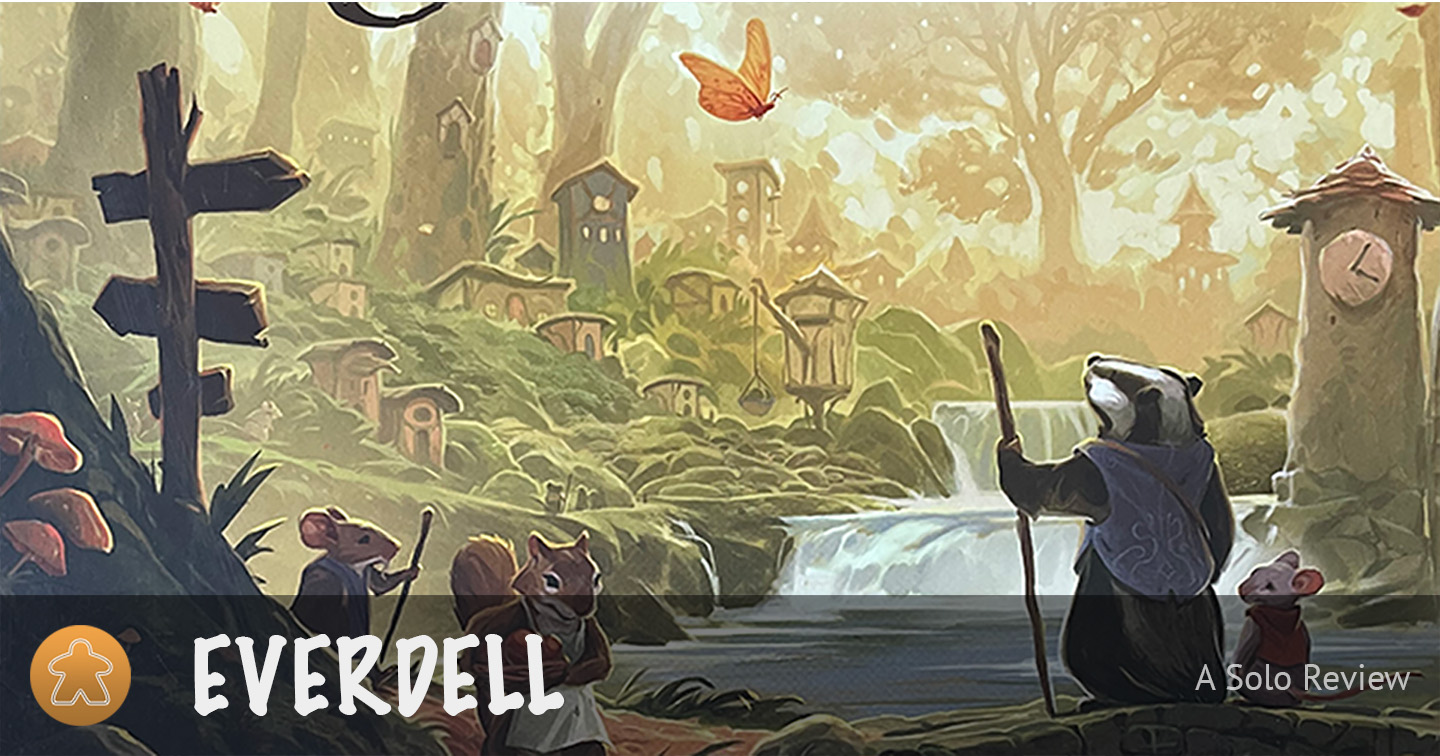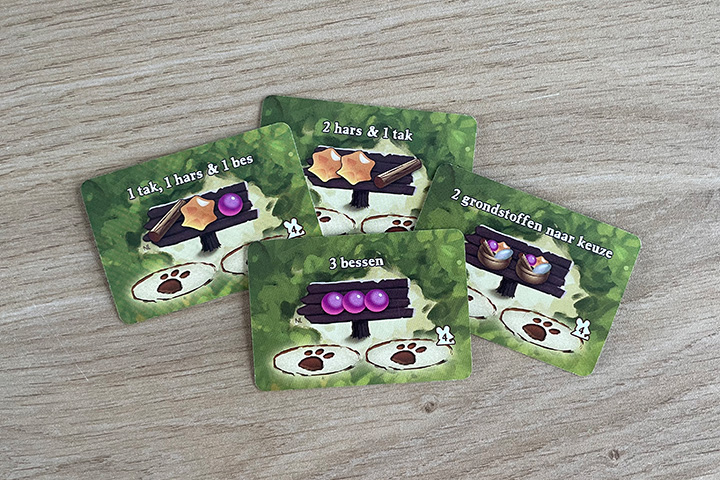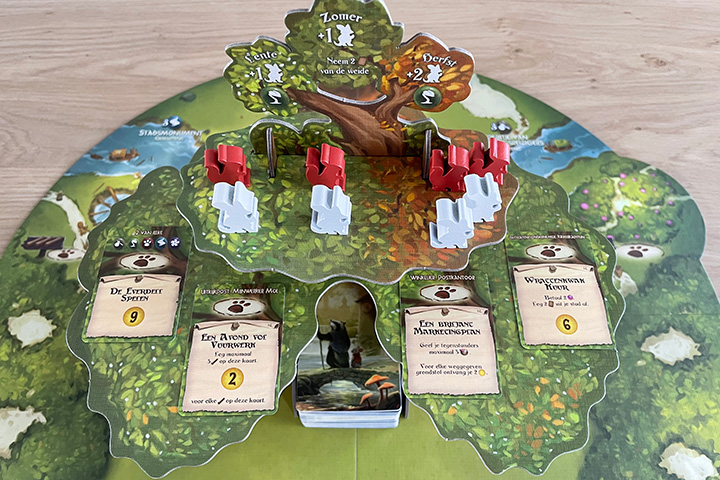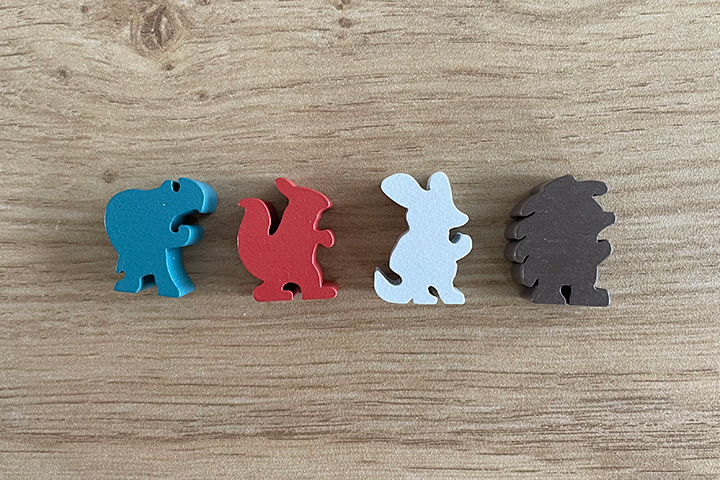Everdell - A Solo Review
22 Jul 2021
Long ago, adventurer Corrin Evertail discovered a charming valley and named it Everdell. Since then the place has been a thriving civilization of forest critters. The time has come to expand into new territories and establish new cities. Can you help the lovely creatures build a new place to live before the year is over?
Name: Everdell
Designer: James A. Wilson
Publisher: Starling Games (White Goblin Games, for the Dutch edition I have)
Game type: worker placement, card drafting, tableau building
What is Everdell?
Everdell is a mix of worker placement and tableau building where you use your workers to gather resources and cards. You then use those resources to play the cards into your tableau, which is basically the village you’re building, while the cards are the buildings and critters.
The cards you use to build your village score you points at the end of the game. They also come with various benefits to make things easier for you by giving you extra resources at the start of rounds or reductions when contructing a building and so on. Finally, they let you gain special event cards and tiles, which will also score you points at the end of the game.
How does it play?
The game takes place over four seasons or rounds. Thematically, the game begins in late winter and ends right before the next winter starts.
At the start of the game, you get five random cards and two of your six workers. The rest of your workers are gradually given to you round per round. One extra worker in round two and three, and two extra workers in round four.
Every round is divided into turns and in each turn you can either place a worker or play a card. Since the AI opponent doesn’t actively take turns, you can just do everything you want to do in one go in the solo version.
Getting resources and cards
There are four different types of resources in Everdell: twigs, resin, pebbles and berries. To gather resources and cards you can make use of the different action spaces by placing one of your workers on them.
The game board comes with eight basic action spaces. These action spaces allow you to either take a certain amount of one type of resource, like three twigs, or a combination of one type of resources and cards, like two twigs and a card or two cards and a victory point token.
Next to those basic action spaces, the board also has a few locations for so called Forest Cards. At the beginning of the game you take three random Forest Cards and place them on the board. These Forest Cards contain additional, often more powerful, action spaces like “Take any two resources”, “Discard up to three cards and gain any one resource for each card” or “Take one twig, one resin and one berry”.

Some action spaces can have more than one worker on them, but most can only be used once per round, so you’ll have to plan carefully when placing workers on action spaces.
Playing cards
Once you have some resources, you can play cards. You can either play a card from your hand or from the eight shared cards in the middle of the board, called the Meadow.
Playing a card means paying the required amount of resources and adding it to your tableau in front of you. There are also ways to play a card for free. Every critter lives or works in one of the buildings you can have, so for example, if you have the courthouse card in your tableau, you can play the judge card for free if you have it in your hand or if it is in the Meadow.
There are five types of cards in the game:
- Traveler cards (tan): these have a one-time action that activates the moment you play the card.
- Production cards (green): these activate when played, just like the traveler cards, but they also activate when preparing for the next season in spring and autumn. More on that later.
- Destination cards (red): these come with their own action space where you can place a worker.
- Governance cards (blue): these offer bonuses after playing certain cards types, like a discount when playing a building.
- Prosperity cards (purple): these score you extra points at the end of the game.
There are some limits to your tableau/village. For example, you cannot have more than 15 cards in there and you can only have one copy of “unique” cards. (There are multiple copies of that card in the deck, they are only unique to your village.)
Getting event cards and tiles
There are four basic event tiles and four special event cards on the game board. The tiles are the same every time, but the event cards are randomised at the start of the game.
Whenever you meet the requirements for one of the cards or tiles, you can use a worker to take it. For the tiles, the requirements all have to do with the card types in your village. The Grand Tour event tile for example can be taken once you have three red (destination) cards and it is worth three points at the end of the game. For the special event cards, the requirements are a lot more specific. One example is the Pristine Chapel Ceiling card which requires you to have a woodcarver and a chapel in your village.
With 128 cards in the game, the chances of getting the exact requirements for an event card are pretty slim. Getting one of them is a nice bonus, but I never try to work towards it because it relies a lot on the luck of the draw.
Preparing for next season
Once you have placed all your workers and played all the cards you want to play, the round ends and you prepare for the next season, as the game calls it. Preparing for next season just means taking back all the workers you placed, getting your extra worker(s) for the next round and executing the bonus effects of the next round. For round two (spring) and four (autumn) this means activating all your green production cards, which usually give you extra resources. In round three (summer) you get to take two cards from the meadow and add them to your hand.
At the end of the fourth round there is no prepare for next season phase, because it was the final round of the game. Instead you count up all the points you have gathered from the cards you played, the events you collected and possibly from any workers you have on the journey action spaces.
If you score more points than your AI opponent you win the game.
How does the AI work?
The AI in Everdell is a rat called Rugwort and it is not really an AI. The main purpose of Rugwort is to block action spaces and prevent you from taking certain cards from the Meadow.
Just like you, Rugwort starts with only two workers and gains some more every season. These workers always block the same places every game:
- Round 1: the “Take three twigs” action space and the top left Forest Card action space.
- Round 2: the “Take two resin” action space, the bottom left Forest Card and the first card card in the Meadow.
- Round 3: the “Take one pebble” action space, the top right Forest Card and the first two cards in the Meadow.
- Round 4: the “Take one berry and one card” action space, the first four cards in the Meadow and the 3-point Journey space. (There are four Journey spaces, worth 2, 3, 4 or 5 points. You can place a worker on any of them in the last round, but you need to be able to discard a number of cards equal to the amount of points it gives.)
This makes Rugwort very predictable. Luckily there is also some form of randomness to the rat, because every time you play a card, Rugwort also takes one from the Meadow and adds it to his village. To determine which card he takes you have to roll an eight-sided die. Next to that Rugwort can also claim the basic event tiles if he meets the requirements at the end of a round.
At the end of the game, he scores two points for every card in his village, an extra point for every purple card, three points for his worker on the Journey space, three points for every basic event tile and three points for every special event card you did not achieve.
There are three levels of difficulty. The main difference is the number of points he gets for the special event cards you did not achieve and which Journey space he blocks and scores, but on the highest difficulty, he also kidnaps one of your workers in the last round! So you will have one worker less to get things done. The same goes for Rugworth though, because he used one of his workers to kidnap one of yours.
What does it look and feel like?
I can’t believe I have made it so far without mentioning the big cardboard Ever Tree! If there is one thing that defines Everdell, it has to be the tree. You have to assemble it out of five pieces of cardboard and you place it at one end of the game board. The trunk of the tree holds the deck of cards, the bottom branches hold the four special event cards and the top branches hold the extra workers you get every season along with the reminder which special action happens that season.


While the tree definitely looks very impressive and pretty and adds to the overall look and feel of the game, it is not always very practical. If you want to know which special event cards are in play, you have to get up out of your seat to be able have a look at the cards. But that’s only a minor inconvenience. You can certainly play the game without the tree and just place the special event cards and extra workers somewhere next to the game board, but I always put the tree together and use it because it looks so good.
The tree isn’t the only thing that looks great.


The resources aren’t just cardboard or wooden tokens here. The twigs are these tiny brown plastic detailed logs of wood. The resin pieces are beautiful translucent orange bits. The pebbles are smoothly shaped and look like actual real pebbles. The berries are made out of some sort of rubbery material and are a bit squishy. Lovely!
The cards are very high quality with a linen finish. I have read somewhere that one advantage of the cardboard tree is that it prevents the big deck of cards from falling over if they’re sleeved, but honestly, I haven’t felt the need to sleeve these cards. They are really high quality and you only shuffle them once per game.
The art on the cards is superb as well. There is loads of detail in there and when I draw a card I haven’t seen that often, I sometimes catch myself just staring at it.
Great quality all over the place in this game!
How much time does it take?
My first few games took me well over an hour, but once I got the hang of the game and had a better idea of which cards are in the game, what they do and how they can be combined, I got it down to around 45 minutes.

Setup and teardown is pretty quick. The game comes with an insert to hold the cards and the rest (resources, workers, tokens) just go into baggies. The tree is assembled and disassembled in no time as well.
Including setup and teardown, I’m pretty confident I can finish a game in less than an hour.
What is my verdict?
You start the game with five cards, no resources and only two workers. Even after having played the game quite a few times I always get that slight feeling of hopelessness at the beginning, wondering how I’m even going to get one or two cards into my village, but I have managed to get all 15 cards into my tableau by the end of every game I played. The resource scarcity is an integral part of the game and turns it into a really fun efficiency puzzle.
While the AI is pretty predictable, I find it adds just enough variability to keep things interesting. And since you’re often struggling to get resources, having some predictability isn’t that bad.
I don’t get Everdell to the table as often as I did when I first got it, but I think that’s mostly because my preferences have shifted to towards the slightly heavier or complex spectrum of board games. Nevertheless, whenever I do get it to the table I always greatly enjoy it.
Score
To make things easier for myself, I use the same scoring categories Board Game Geek uses.
Comments
I'm sorry, I don't support comments on my website. If you want to discuss the game or my review, feel free comment on this dedicated Instagram post or my review on BGG.